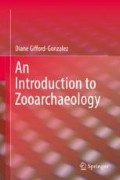Abstract
As stipulated in Chapter 3, contemporary observations are a rich source of knowledge about functional properties of the animal remains that zooarchaeologists study. This chapter reviews intrinsic properties of bone as a living tissue, which exist because of the evolutionary histories and specific life circumstances of individual vertebrates. Zooarchaeologists can use such inherent features to infer the age, sex, season of death of an animal, and to understand peri- and postmortem modifications to skeletal elements. This chapter outlines the origins and histology of bone tissue, bone tissue micro-architecture, macroscopic structural variants, and shape-based bone classifications, as well as pathways of bone growth and development. It briefly describes the histology of teeth and their growth and morphology in mammals. A knowledge of these traits of living organisms permits a more systematic understanding of those qualities of animal bodies that attract humans and strongly determine the condition of archaeofaunal specimens.
Access this chapter
Tax calculation will be finalised at checkout
Purchases are for personal use only
References
Barlet, J. P., Coxam, V., & Davicco, M. J. (1995). Physical activity and the skeleton. Archives of Physiology and Biochemistry, 103(6), 681–698.
Baron, R. (1993). Anatomy and ultrastructure of bones. In M. J. Favus (Ed.), Primer on the metabolic bone diseases and disorders of mineral metabolism (2nd ed., pp. 3–9). New York: Raven Press.
Blair, H. C., Zaidi, M., & Schlesinger, P. H. (2002). Mechanisms balancing skeletal matrix synthesis and degradation. Biochemical Journal, 364(Pt2), 329–341.
Carlson, S. J. (1990). Vertebrate dental structures. In J. G. Carter (Ed.), Skeletal biomineralization: Patterns, processes and evolutionary trends (pp. 531–556). New York: van Nostrand Reinhold.
Chan, G. K., & Duque, G. (2002). Age-related bone loss: Old bone, new facts. Gerontology, 48(2), 62–71.
Chaplin, R. E. (1971). The study of animal bones from archaeological sites. New York: Seminar Press.
Corsi, A., Xu, T., Chen, X. D., Boyde, A., Liang, J., Mankani, M., et al. (2002). Phenotypic effects of biglycan deficiency, are linked to collagen fibril abnormalities, are synergized by decorin deficiency, and mimic Ehlers-Danlos-like changes in bone and other connective tissues. Journal of Bone and Mineral Research, 17(7), 1180-1189, doi:10.1359/jbmr.2002.17.7.1180.
Cuijpers, A. G. F. M. (2006). Histological identification of bone fragments in archaeology: Telling humans apart from horses and cattle. International Journal of Osteoarchaeology, 16(6), 465–480.
Cuijpers, S., & Lauwerier, R. C. G. M. (2008). Differentiating between bone fragments from horses and cattle: A histological identification method for archaeology. Environmental Archaeology, 13(2), 165–179.
Forwood, M. R., Owan, I., Takano, Y., & Turner, C. H. (1996). Increased bone formation in rat tibiae after a single short period of dynamic loading in vivo. American Journal of Physiology – Endocrinology and Metabolism, 270(3), E419–E423.
Galloway, A. (1997). The cost of reproduction and the evolution of postmenopausal osteoporosis. In M. E. Morbeck, A. Galloway, & A. Zihlman (Eds.), The evolving female: A life history perspective (pp. 132–146). Princeton: Princeton University Press.
Jones, T. C., & Howat, P. M. (2002). The effect of diet/supplement intake and competitive activity on bone mineral density of collegiate females. The Federation of American Societies for Experimental Biology Journal, 16(4), A629.
Jones, H. H., Priest, J. D., Hayes, W. C., Tichenor, C. C., & Nagel, D. A. (1977). Humeral hypertrophy in response to exercise. Journal of Bone and Joint Surgery, 59-A, 204–208.
Lipson, S. F., & Katz, J. L. (1984). The relationship between elastic properties and microstructure of bovine cortical bone. Journal of Biomechanics, 17(4), 231–235,237-240.
Liu, B.-Y., Wu, P.-W., Hsu, Y.-T., Leu, J.-S., & Wang, J.-T. (2002). Estrogen blocks parathyroid hormone-stimulated osteoclast-like cell formation in modulating differentiation of mouse marrow stromal cells in vitro. Journal of the Formosan Medical Association, 101(1), 24–33.
Lyman, R. L. (1994). Vertebrate taphonomy. Cambridge: Cambridge University Press.
MacGregor, A. (1985). Bone, antler, ivory, and horn: The technology of skeletal materials since the Roman period. Totowa: Barnes & Noble.
Martiniakova, M., Grosskopf, B., Omelka, R., Vondrakova, M., & Bauerova, M. (2006). Differences among species in compact bone tissue microstructure of mammalian skeleton: Use of a discriminant function analysis for species identification. Journal of Forensic Sciences, 51(6), 1235–1239.
Richter, J. (1986). Experimental study of heat induced morphological changes in fish bone collagen. Journal of Archaeological Science, 13(5), 477–481.
Ruangwit, U. (1967). The split-line phenomenon and the microscopic structure of bone. American Journal of Physical Anthropology, 26(3), 319–329.
Ruscillo, D. (Ed.). (2006). Recent advances in ageing and sexing animal bones. Oxford: Oxbow Books.
Silver, I. A. (1963). The ageing of domestic animals. In D. R. Brothwell & E. Higgs (Eds.), Science in archaeology: A comprehensive survey of the progress and research (pp. 283–302). New York: Praeger.
Stiner, M. C., Kuhn, S. L., Weiner, S., & Bar-Yosef, O. (1995). Differential burning, recrystallization, and fragmentation of archaeological bone. Journal of Archaeological Science, 22(2), 223–237.
Tanner, J. M. (1990). Fetus into man. Physical growth from conception to maturity (Revised ed.). Cambridge: Harvard University Press.
Tappen, N. C., & Peske, G. R. (1970). Weathering cracks and split-line patterns in archaeological bone. American Antiquity, 35(3), 383–386.
Taylor, R. E., Hare, P. E., & White, T. D. (1995). Geochemical criteria for thermal alteration of bone. Journal of Archaeological Science, 22(1), 115–119.
Termine, J. D. (1993). Bone matrix proteins and the mineralization process. In M. J. Favus (Ed.), Primer on the metabolic bones diseases and disorders of mineral metabolism (2nd ed., pp. 21–25). New York: Raven Press.
Zococo, T. G., & Schwartz, H. (1994). Microstructural analysis of bone of the sauropod dinosaur Seismosaurus by transmission electron microscopy. Paleontology, 37(3), 493–503.
Author information
Authors and Affiliations
Rights and permissions
Copyright information
© 2018 Springer International Publishing AG, part of Springer Nature
About this chapter
Cite this chapter
Gifford-Gonzalez, D. (2018). Bone and Vertebrate Bodies as Uniformitarian Materials. In: An Introduction to Zooarchaeology. Springer, Cham. https://doi.org/10.1007/978-3-319-65682-3_4
Download citation
DOI: https://doi.org/10.1007/978-3-319-65682-3_4
Published:
Publisher Name: Springer, Cham
Print ISBN: 978-3-319-65680-9
Online ISBN: 978-3-319-65682-3
eBook Packages: Social SciencesSocial Sciences (R0)

